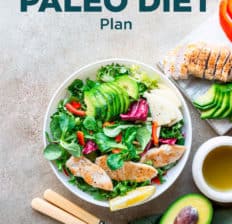This Dr. Axe content is medically reviewed or fact checked to ensure factually accurate information.
With strict editorial sourcing guidelines, we only link to academic research institutions, reputable media sites and, when research is available, medically peer-reviewed studies. Note that the numbers in parentheses (1, 2, etc.) are clickable links to these studies.
The information in our articles is NOT intended to replace a one-on-one relationship with a qualified health care professional and is not intended as medical advice.
This article is based on scientific evidence, written by experts and fact checked by our trained editorial staff. Note that the numbers in parentheses (1, 2, etc.) are clickable links to medically peer-reviewed studies.
Our team includes licensed nutritionists and dietitians, certified health education specialists, as well as certified strength and conditioning specialists, personal trainers and corrective exercise specialists. Our team aims to be not only thorough with its research, but also objective and unbiased.
The information in our articles is NOT intended to replace a one-on-one relationship with a qualified health care professional and is not intended as medical advice.
Paleo Diet Beginner’s Guide, Including Best vs. Worst Foods
September 4, 2022

In the past few decades, our diets have changed dramatically. Highly processed foods are more common than fruits and vegetables, as Americans opt for convenient choices that fit in to their busy lifestyles. Enter the Paleo diet plan, which seeks to ditch processed options in favor of the foods eaten by our ancestors.
The Paleo diet has been associated with many health benefits, from better blood sugar levels to reduced inflammation. It’s considered one of the best diets to lose weight because it’s high in protein and fat and emphasizes the consumption of nutrients.
It may also increase satiety and help correct nutrient deficiencies. Still, the diet has remained the subject of much controversy in recent years.
Despite this, the Paleo diet plan remains very popular, and there is a massive community of people who swear by it, claiming that it can be a convenient, easy-to-follow and effective way to attain better health.
So what is it, and does it work? Here’s your Paleo diet beginner’s guide.
What Is a Paleo Diet?
The Paleo diet definition is simple: Eat only foods that were available to our hunter and gatherer ancestors thousands of years ago during the Paleolithic Age. This means that things like processed foods, refined grains and cereals are off the table, and instead your plate should be full of fruits, vegetables, nuts, seeds and high-quality meats.
The idea is that these are the foods that our bodies were designed to eat while many of the heavily processed modern products consumed today contribute to chronic disease and health problems. Proponents of the diet suggest that a well-planned Paleo diet could lead to improvements in many aspects of health, such as enhanced weight loss and reduced inflammation.
Because it is essentially a grain-free diet, it tends to be lower in carbohydrates and higher in protein and fat than some other diets. However, it also eliminates several food groups that contain beneficial nutrients, such as legumes and dairy, which has made Paleo the subject of much debate among experts.
The Paleo diet can be traced back to gastroenterologist Walter Voegtlin, who brought up the idea of eating like our ancestors in 1975 in his book “The Stone Age Diet.” A decade later, researchers Melvin Konner and Stanley Boyd Eaton published a paper on the Paleo diet in the New England Journal of Medicine, which is considered one of the foundations of the Paleo diet as we know it today.
However, scientist Dr. Loren Cordain is most often credited with founding the modern Paleo movement when he wrote “The Paleo Diet” in 2002 along with a multitude of other books on the Paleo diet in the following years.
It wasn’t until the last decade that Paleo really started to catch on, though. By 2013, it was ranked as the most searched weight loss method on Google.
Today, the Paleo diet remains very popular and has a huge fan base of dedicated followers that enjoy the flexibility and benefits it provides.
There are several different variations of Paleo, each of which comes with its own set of rules, regulations and guidelines. Here are a few of the most common options to consider when going Paleo:
- Standard Paleo Diet: This version follows all of the rules of a traditional Paleo diet. Grains, legumes and processed foods are off the table, and the focus is instead placed on whole foods, like fruits, veggies, nuts, seeds and meats.
- Autoimmune Paleo Diet: Also known as the AIP diet, this variation involves cutting out foods that trigger inflammation and then slowly reintroducing them to determine which you’re able to tolerate. This diet is best suited for those with autoimmune disorders, such as rheumatoid arthritis or lupus.
- 80/20 Paleo Diet: If you can’t imagine giving up grains altogether, this may be the right fit for you. The 80/20 diet involves following a strict Paleo diet 80 percent of the time and enjoying your favorite non-Paleo foods during the remaining 20 percent.
- Pegan Diet: Combining the principles of the vegan diet and Paleo diet, the “Pegan diet” focuses on plant-based whole foods while excluding animal products altogether. This diet remains somewhat controversial, as some claim that the inclusion of animal products is crucial to achieving results while following the Paleo diet.
- Primal Diet: Much like the Paleo diet, the Primal diet is centered around following a way of eating similar to our ancestors. However, on the Primal diet, raw, full-fat dairy is permitted and also allows the consumption of certain types of legumes and fermented soy products.
Related: What Is the Boiled Egg Diet? Benefits, How to Follow, Risks & More
Health Benefits
1. Promotes Weight Loss
Is the Paleo diet good for weight loss? Although results can vary quite a bit, following Paleo has helped many people lose weight.
By swapping processed foods and refined sugars for nutrient-rich proteins and healthy fats, you can cut calories and kick-start weight loss. (Learn “how many calories should I eat a day?”)
The plan encourages fruits and vegetables, which are high in slow-digesting fiber, along with healthy fats and protein, which increase satiety and reduce appetite.
Keep in mind that the amount of Paleo diet weight loss can vary depending on many factors, such as what your diet was like beforehand. While some people may see the inches and pounds slide off after starting Paleo, others may not see such dramatic results.
2. High in Protein
Getting enough protein is essential to maintaining overall health. Protein is vital for repairing and rebuilding tissue cells, maintaining normal blood sugar, transporting oxygen, healing wounds, and building muscle mass.
A protein deficiency can lead to a host of negative side effects, including low energy levels, decreased immunity, poor concentration and slow wound healing.
Protein is one of the staples of Paleo. In fact, the plan encourages filling your plate with plenty of protein foods, such as grass-fed beef, poultry and seafood.
3. Reduces Inflammation
Inflammation is a normal bodily response triggered by the immune system to protect against foreign invaders. Prolonged or chronic inflammation, however, is at the root of most diseases, including chronic conditions like cancer, heart disease and diabetes.
The Paleo diet plan encourages eating plenty of anti-inflammatory foods, such as fruits, vegetables, nuts and seeds. Fruits and vegetables are high in antioxidants, which help neutralize the harmful free radicals that contribute to inflammation in the body. Meanwhile, nuts and seeds tend to be high in anti-inflammatory omega-3 fatty acids.
Reducing inflammation can also be beneficial in reducing symptoms of inflammatory or autoimmune conditions, such as rheumatoid arthritis, lupus or ulcerative colitis.
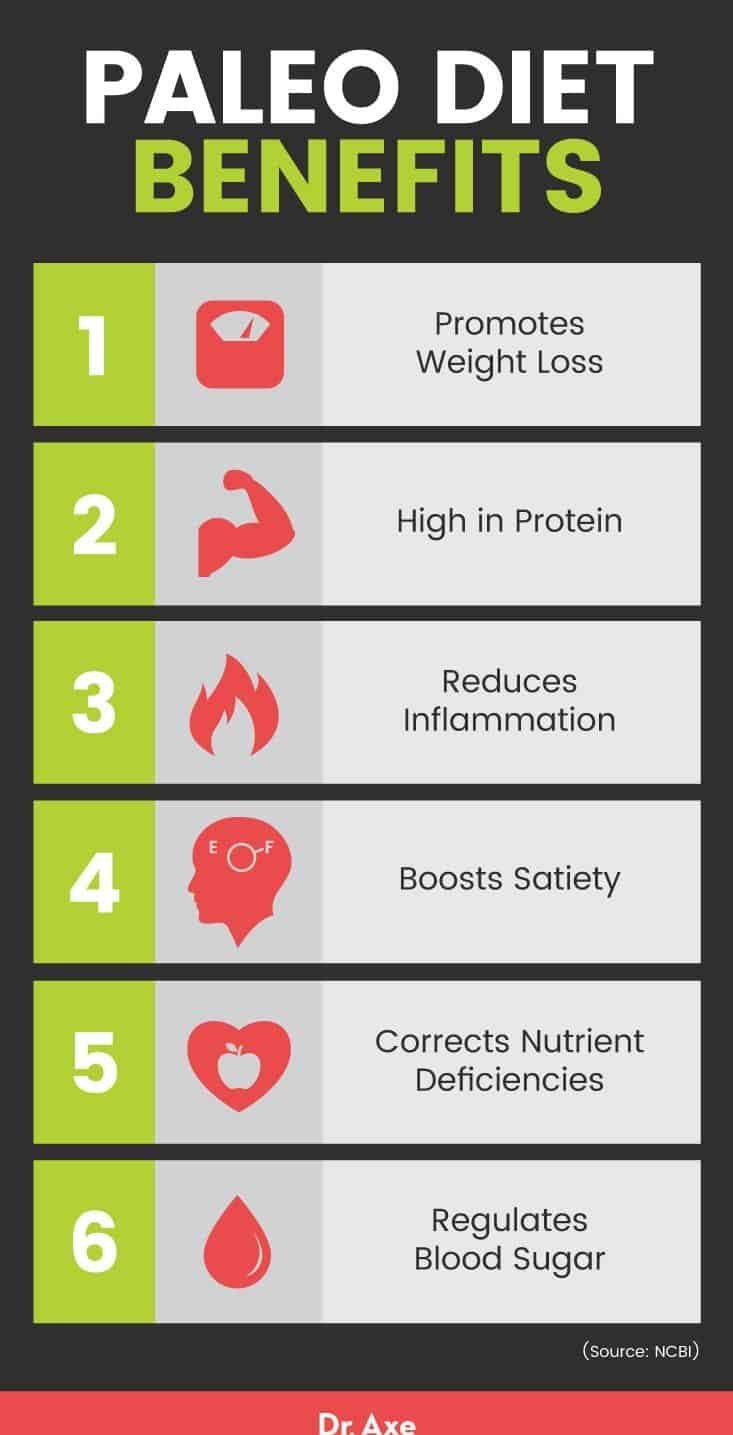
4. Boosts Satiety
Paleo eating puts the emphasis on packing in plenty of heart-healthy fats and proteins into your meals, which can help support satiety and reduce appetite.
Fat is digested very slowly, so it stays in the stomach for longer and keeps you feeling full. Meanwhile, a high-protein diet can reduce levels of ghrelin, the hunger hormone, to reduce appetite.
Protein has also been shown to kick-start your metabolism and decrease caloric intake.
Furthermore, the Paleo diet plan limits foods like refined grains and processed foods that are typically digested very quickly, leading to spikes and crashes in blood sugar levels as well as increased levels of hunger.
5. Corrects Nutrient Deficiencies
One of the biggest benefits of the Paleo diet is that it prioritizes nutrient-dense foods over heavily processed or refined foods. These choices supply important micronutrients that you may be missing from your diet, helping reduce a wide range of symptoms, from brain fog to chronic fatigue.
Increasing your intake of red meat, for instance, can provide more iron, while adding more nuts and seeds into your diet can up your intake of omega-3 fatty acids.
If you have any nutrient deficiencies and are currently consuming a diet rich in “empty calories” from nutrient-poor products like junk food, switching to Paleo may help you fit more nutrients into your diet.
6. Regulates Blood Sugar
While not as extreme as a very low- or no-carb diet, Paleo does restrict many types of carbohydrates, such as cereal grains. This may positively impact your blood sugar levels.
Paleo also emphasizes nutrients like fat and protein, which are digested slowly, keeping blood sugar levels stable.
A study published in the European Journal of Clinical Nutrition compared the benefits of following a Paleo diet versus a diet recommended by the American Diabetes Association in 24 participants with diabetes. After two weeks, researchers found that the Paleo diet led to greater improvements in blood sugar levels and insulin sensitivity than the conventional diabetes diet.
Of course, lifestyle factors also play an important role in diabetes prevention. In addition to making dietary modifications, exercising regularly, reducing stress levels and drinking plenty of water can also help you maintain normal blood sugar.
7. Supports Heart Health
Promising research shows that the Paleo diet could be beneficial for heart health. In fact, it’s been shown to reduce several heart disease risk factors to help keep your heart healthy and strong.
In one study out of Sweden, following a Paleo diet for just five weeks produced a significant reduction in blood pressure, triglycerides and cholesterol levels in postmenopausal women.
Another study showed that Paleo was effective at increasing levels of good HDL cholesterol, which moves through the bloodstream clearing fatty plaque to help prevent atherosclerosis.
Paleo Diet Plan Guide
Looking for a resource on the Paleo diet for beginners? Look no further.
In this Paleo diet plan beginner’s guide, you’ll find more on the Paleo diet basics, some quick tips for maximizing your success on the Paleo diet for the long term, which Paleo foods you should include or avoid on the plan, and some tasty recipes to get you started.
- Trying a 30-day Paleo meal plan can help you decide if it’s right for you and if it can help you achieve your goals — whether that includes weight loss, increased energy, lower blood pressure or simply overall better health from healing eating.
- If the regular Paleo diet feels overly restrictive or difficult to follow, try a modified version instead. There are plenty of options available, making it easy to find something that works for you.
- Print out a list of healthy Paleo foods, and bring it with you to the grocery store for an easy reference. Look for organic fruits, vegetables and unprocessed foods with minimal added ingredients to ensure you’re getting the best quality.
- As a simple rule of thumb, opt for whole foods that have been minimally processed whenever possible. Products with long lists of ingredients are often pumped full of preservatives, additives and artificial sweeteners that you’re better off without.
- One of the best ways to avoid unhealthy cravings and snack foods is to simply keep them out of your kitchen altogether. Be sure to keep plenty of healthy snacks on hand, and kick the junk foods to the curb.
- Although there are plenty of Paleo meal plan delivery sites out there, doing your own grocery shopping and preparing your meals at home can give you more control over your meals and can help you take full advantage of the potential benefits of Paleo.
- It can be easy to load your diet up with fried bacon and butter and still technically be following a Paleo diet plan. However, to get the most from Paleo, opt for lots of fruits, vegetables, unprocessed meat and poultry, and heart-healthy fats, along with a few servings of seafood per week.
- Eat when you feel hungry, and don’t worry about counting calories (such as in the CICO diet) or macronutrients. The idea is to do what feels most natural to you and listen to your body.
- If you find that you’re not losing weight, consider cutting back on high-carb, high-fat foods, such as nuts, seeds and oils. While these foods are fine in moderation, they’re also high in calories and may make it difficult to lose weight.
- Any diet should be paired with a healthy lifestyle to maximize results for the long term. Exercise regularly, reduce your stress levels, stay well-hydrated and avoid unhealthy habits, and you’ll be much more likely to achieve your health goals with the Paleo diet plan.
Sample Menu
What can you eat on the Paleo diet? If you’re curious what a typical Paleo breakfast, lunch and dinner may look like, you’re in luck.
Check out this sample Paleo meal plan for some inspiration to help plan out your weekly menu:
Day One
- Breakfast: Scrambled eggs with fruit salad
- Lunch: Moo shu chicken lettuce wraps
- Dinner: Grilled salmon with roasted broccoli
Day Two
- Breakfast: Grain-free oatmeal
- Lunch: Stir-fry with grass-fed beef and mixed veggies
- Dinner: Salad with chicken, avocado, tomatoes, spinach and almonds
Day Three
- Breakfast: Veggie omelet
- Lunch: Fish taco bowl with cauliflower rice, tomatoes, avocado, lettuce and cilantro
- Dinner: Mediterranean grilled lamb chops with sweet potato wedges
Recipes
Even after going Paleo, you can still enjoy most — if not all — of your favorite foods with a healthy wist. Try swapping regular burgers for lettuce burgers, pizza crust for cauliflower crust and wheat flour for coconut flour to give your diet a nutritious, Paleo-friendly makeover.
Wondering what a typical day on Paleo looks like? There are plenty of recipes out there for everything from Paleo desserts to dinners. Here are a few simple Paleo diet recipes to get you started:
- Banana Egg Paleo Pancakes
- Crockpot Collard Greens with Cajun Spices
- Turkey Wonton Soup
- Bone Broth-Braised Short Ribs
- Tropical Acai Bowl with Mango and Hemp Seeds
- Paleo Zucchini Brownies with Dark Chocolate Chips
- Gluten-Free Lemon Meringue Pie
Food List
Following the Paleo diet plan can be a bit tricky, as it can be challenging to know which foods you should include and which you should avoid. Here is a healthy Paleo diet food list with some options that you should include in your meals and snacks:
- Meat: grass-fed beef, lamb, goat, etc.
- Seafood: wild-caught salmon, trout, mackerel, haddock, etc.
- Poultry: free-range chicken, turkey, duck, etc.
- Fresh fruits: apples, oranges, berries, melons, pears, etc.
- Fresh vegetables: broccoli, cauliflower, spinach, tomatoes, carrots, kale, asparagus, cucumbers, etc.
- Eggs
- Nuts: almonds, cashews, walnuts, Brazil nuts, hazelnuts, etc.
- Seeds: flaxseeds, chia seeds, sesame seeds, pumpkin seeds, etc.
- Heart-healthy, unrefined oils: olive, coconut, flaxseed, walnut and avocado oil
- Spices: turmeric, cumin, garlic powder, basil, oregano, rosemary, etc.
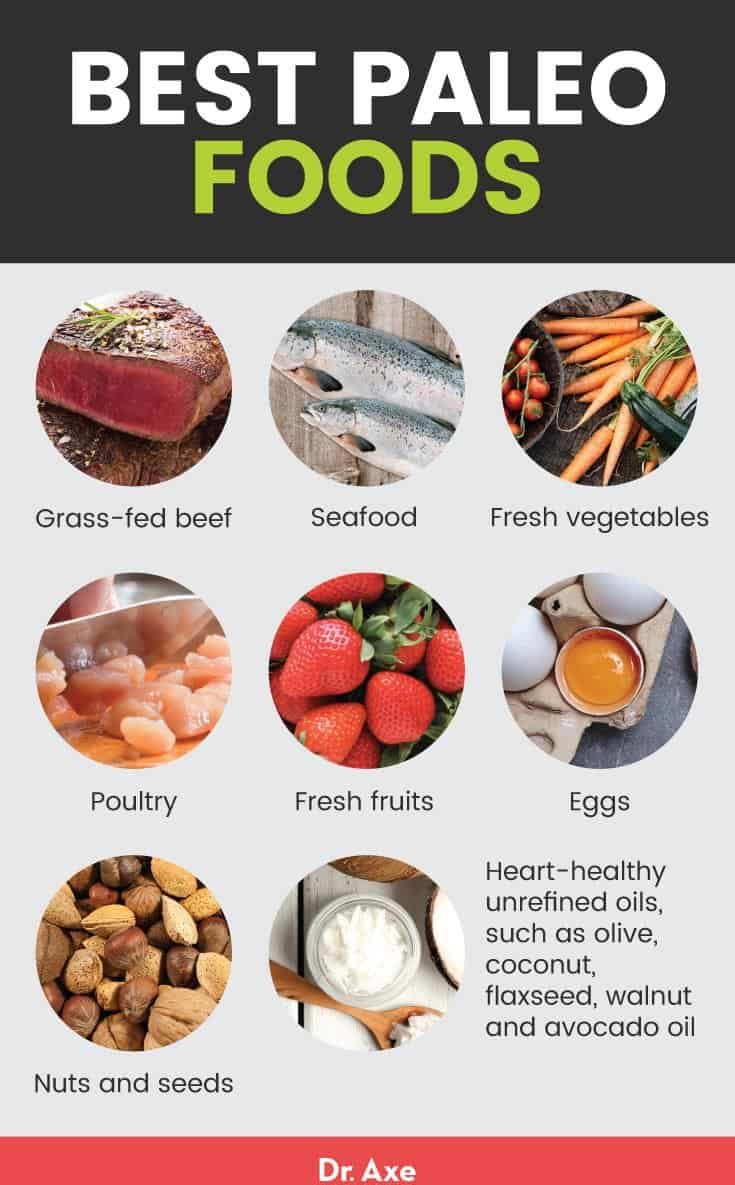
Foods to Avoid
Just as important as knowing which Paleo food groups you can enjoy is knowing which ones you should cut out. Here are the foods that you should avoid while following Paleo:
- Legumes (including beans and peanuts)
- Dairy
- Refined sugar
- Refined vegetable oils
- Processed/junk food
- White potatoes
- Cereal grains
- Sugar-sweetened or caffeinated beverages
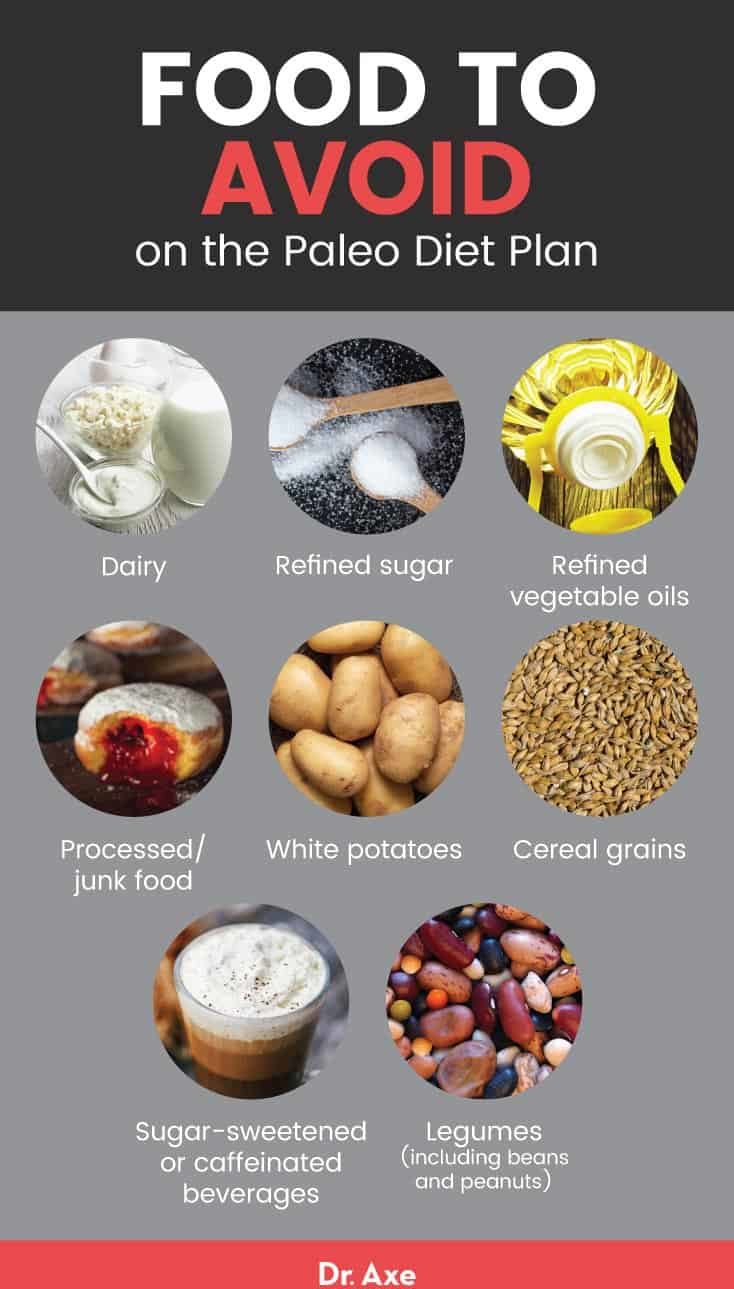
How to Stay Paleo When Eating Out
Creating the perfect Paleo diet shopping list is one thing, but what about when it comes to eating out? Sticking to a Paleo diet menu at social events and restaurants can be a bit more challenging, but it doesn’t have to be.
Next time you’re out, follow these simple Paleo rules to take the stress out of ordering:
- Order a meat-based main dish, such as chicken, beef, or fish.
- Swap out any starches. Try switching buns for lettuce wraps, rice for cauliflower rice and French fries for sweet potato fries.
- Order a veggie as a side dish. Most restaurants offer steamed broccoli, side salads or other veggies as substitutes for no extra charge.
- Ask if it’s possible to have your food cooked in coconut oil or olive oil instead of canola or vegetable oil.
- Skip the sugary desserts, and get a bowl of mixed fruit instead.
Read Next: Macrobiotic Diet Benefits, Theory & Foods
Paleo vs. Keto Diet
The keto diet is a similar eating pattern that has overtaken Paleo in popularity, so is Paleo or keto better?
Both low-carb, low-sugar diets that tend to be nutrient-dense, Paleo and keto eliminate the majority of sources of “empty calories” in the typical Western diet. Plus, both can lead to weight loss, better blood sugar management and much more.
The main difference between the Paleo vs. keto is that the keto diet is higher in fat, while the Paleo diet tends to be higher in protein. While the Paleo diet still includes a variety of healthy fats, the keto diet is very high-fat, since keto fats provide about 75 percent or more of daily calories.
While the Paleo diet eliminates added sugar, grains, beans/legumes and dairy, the keto diet eliminates basically all sources of sugar — this includes fruit and the Paleo go-to starch sweet potatoes. In fact, the keto diet only allows around 20 to 30 grams of “net carbs” (total carb grams minus fiber grams) per day in order to get into nutritional ketosis.
Conversely, on the Paleo diet, the goal is not to get into ketosis, but simply to eat a healthy, balanced diet. Most people on Paleo are not aiming to eat a very specific amount of carbs, unless they are also “counting macros” (the amount of carbs, fat and protein in the diet).
Related: Paleo vs Keto: Differences and What They Have in Common
Is It Safe?
While the Paleo diet plan may come with several benefits to health, there are also some downsides that should be taken into consideration as well.
First of all, it’s unclear if it can really live up to its claim to improve overall health by following the diet of our ancestors. While we can all benefit from reducing our intake of highly processed foods and increasing fruit and vegetable consumption, many dispute whether our ancestors were really all that much healthier than we are today given their significantly shorter life span. In fact, one study even demonstrated that they may have had increased rates of atherosclerosis, or hardened arteries.
The Paleo diet also restricts many foods that are loaded with beneficial nutrients. Legumes, for instance, are high in fiber and protein as well as micronutrients like iron, magnesium, potassium and folate. Dairy products can also be a positive dietary addition, providing calcium, phosphorus and vitamin D.
Additionally, the Paleo diet puts a heavy emphasis on meat products. For this reason, the Paleo diet may not be suitable for everyone, and you’re unlikely to find a modified Paleo diet for vegetarians or vegans out there.
Because Paleo largely cuts out certain food groups, it is not suitable for vegans, vegetarians or those with any major dietary restrictions, as it may be challenging to meet nutrient needs.
While meat in moderation is perfectly healthy, excessive meat consumption may not be. A high intake of red meat, for example, has been linked to an increased risk of mortality and colorectal cancer.
There are also certain foods allowed on the Paleo plan that are not great for your health. Pork, for example, carries a higher risk of parasites, while shrimp often contains unhealthy chemicals and additives. These foods are allowed on the Paleo diet without restriction, but their intake should be moderated on a health-promoting diet.
Similarly, while fried bacon and conventional butter may be Paleo-friendly, include these foods only in moderation. Instead, fill your diet with lots of vegetables and fruits, along with moderate amounts of nuts, seeds, lean sources of protein and heart-healthy fats, to get the most from the Paleo diet.
However, if you have diabetes, you should consult with your doctor before making any major dietary changes. Reducing your carb intake on the Paleo diet may require you to alter your dosage of diabetes medications to avoid fluctuations in blood sugar levels.
Finally, listen to your body. If you experience any prolonged negative symptoms after switching to a Paleo diet, talk to your doctor or dietitian to make sure you don’t have any nutritional gaps that need to be filled in your diet.
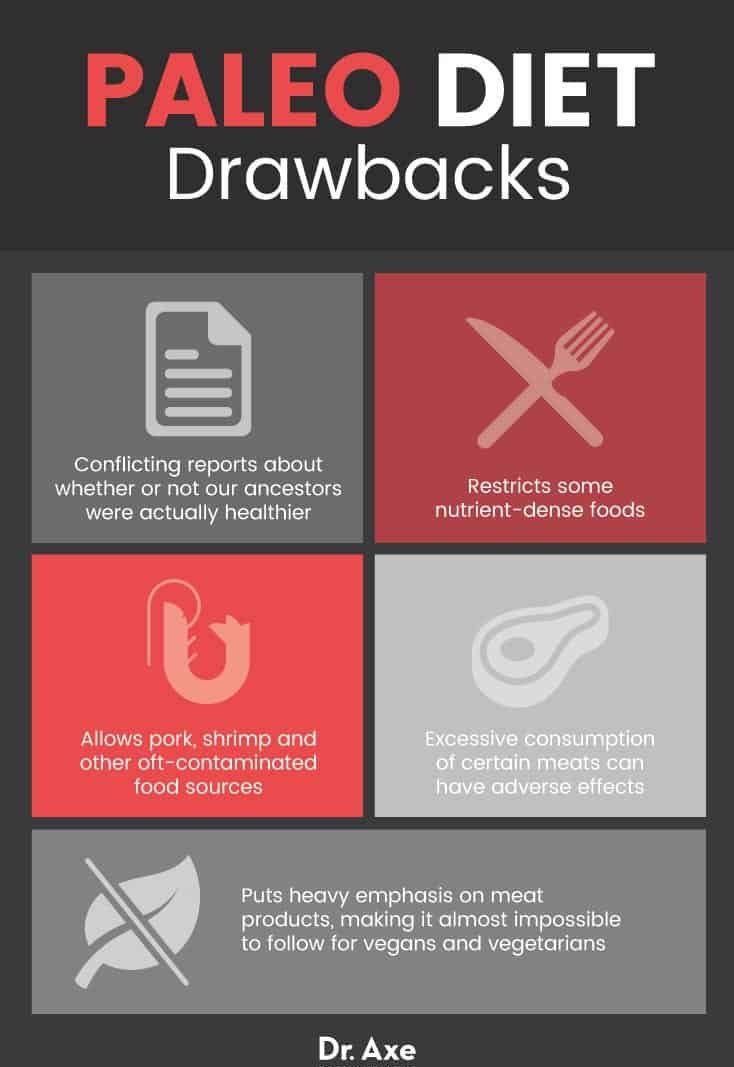
Conclusion
- What is the Paleo diet? This popular diet is based on eating the same foods that were available to our ancestors in the Paleolithic era. You’ve probably seen this method of healthy eating in the news, as it has become one of the most popular ways to lose weight, improve heart health and more.
- Legumes, dairy products, cereal grains and processed foods are the main food groups eliminated from the Paleo diet. Instead, it emphasizes meat, poultry, seafood, fruits, vegetables, nuts, seeds and heart-healthy fats.
- Potential benefits of Paleo include increased weight loss, reduced inflammation, increased satiety and stable blood sugar levels. It also promotes nutrient-dense and high-protein foods, which can support improved health.
- There are also some negative aspects of the diet. Not only is the Paleo diet difficult to follow if you have any dietary restrictions, but it also eliminates several nutrient-rich food groups while allowing several unhealthy foods.
- There are plenty of healthy Paleo recipes out there, including Paleo snacks, meals and desserts, making it easier than ever to follow this plan.













